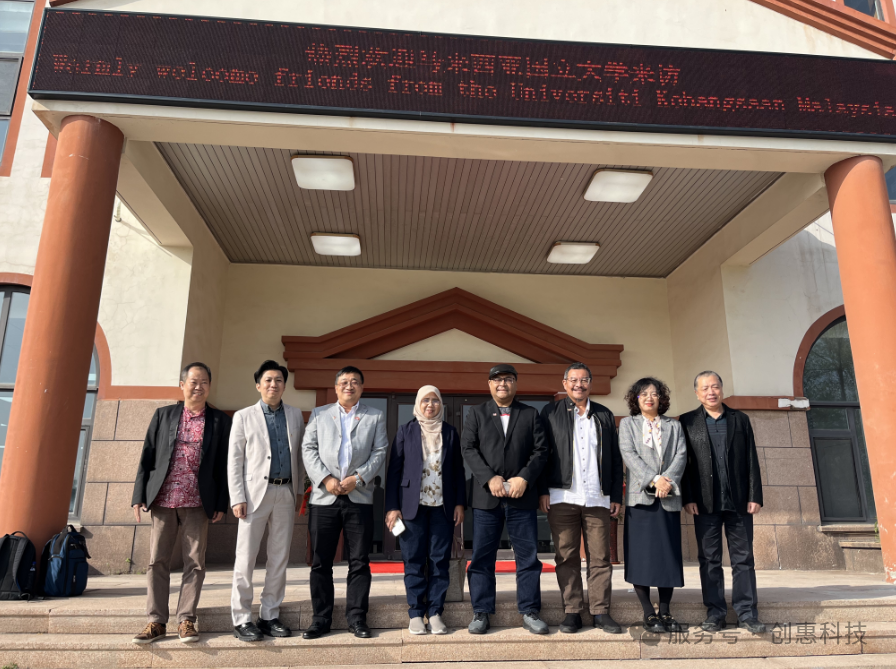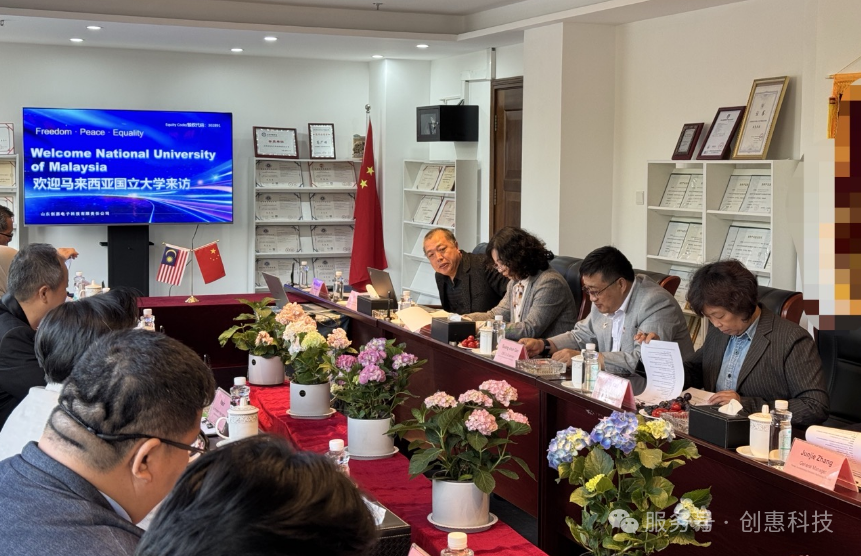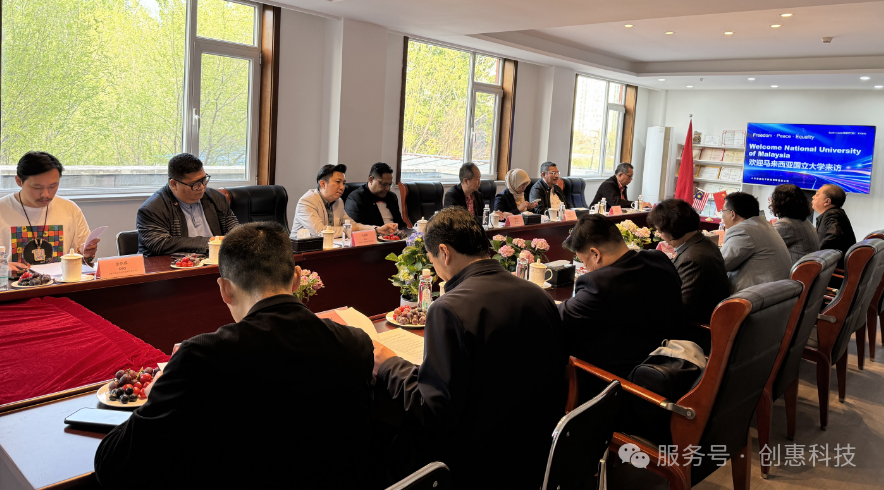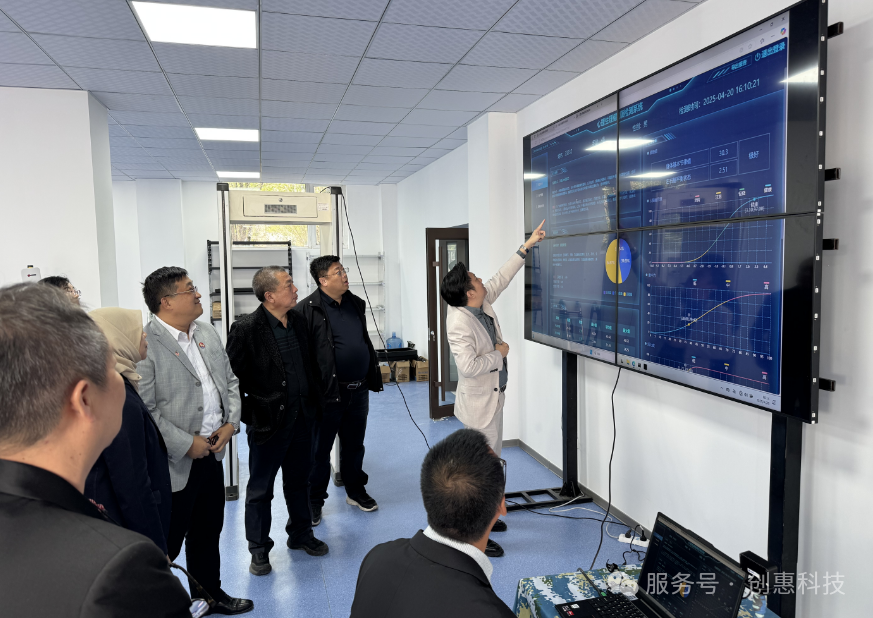Tools & Platforms
Deepen strategic cooperation between AI and intelligent equipment

Shandong Chuanghui Electronic Technology × National University of Malaysia Deepens Strategic Cooperation on AI and intelligent Equipment to Jointly Build a China-Malaysia Science and Technology Innovation Community
As the world enters a new era of intelligent technology, Shandong Chuanghui Electronic Technology Co., Ltd. (hereinafter referred to as “Chuanghui Electronic”) and the Universiti Kebangsaan Malaysia (short form UKM) have once again joined hands to promote the deep integration of AI and robotics technology, and implement the strategic blueprint of jointly building the China-Malaysia Intelligent Technology Industry Research Institute.
Following the signing of a strategic cooperation agreement in Malaysia in March, the UKM delegation officially visited the HQ of Chuanghui Electronics on April 20 as follow, and witnessed the new progress of China-Malaysia AI cooperation together with representatives from the Malaysia-China “The Belt and Road” Research Institute, Chuangfu Tianxia, Shifeng International and many scientific research and corporate representatives.
New opportunities for China-Malaysia cooperation under global trends
During the meeting, both parties agreed that AI and robotics are reshaping human society at an unprecedented speed. According to research data, the global AI economy is expected to exceed 15 trillion US dollars in 2030, and the robotics industry is expected to maintain an average annual growth rate of more than 20%. AI technology has been widely used in key industries such as medicine, agriculture, education, and security, especially in disaster response and public services, showing great social value.


Under the dual background of the Belt and Road Initiative and the 50th anniversary of the establishment of diplomatic relations between China and Malaysia, the scientific and technological cooperation between the two countries is entering a golden period of development. China has leading AI research and development capabilities, while Malaysia enjoys unique geographical, policy and multilingual advantages, and has the potential to radiate to ASEAN. The cooperation between the two sides will accelerate the transformation and implementation of AI achievements in regional markets.
Highlights of strategic cooperation: From laboratory to Industrialization.
On the basis of signing the cooperation agreement in the early stage, this visit further clarified four major cooperation directions:
1. Intelligent equipment research and development: Jointly develop unmanned aerial vehicles and robot dog systems adapted to the Southeast Asian environment, and promote their practical application in scenarios such as agriculture, security, and healthcare.
2.Innovation in defense and countermeasures technology: Develop countermeasures with practical combat capabilities in response to potential threats from drones and robots to enhance the level of public security protection.
3. Co-construction of industry standards and certifications: Jointly formulate industry standards and talent assessment systems to promote the standardization and systematization of AI and robotics technologies.
4. Technology Transfer and localization promotion: Relying on the “China-Malaysia Intelligent Technology Industry Research Institute”, accelerate the promotion of AI technology in the ASEAN market and the cultivation of local talents.
High-level consensus, work together to promote the internationalization process

The meeting was chaired by Mr. Gao Guangshun, Chairman of Chuanghui Electronics. The UKM delegation included Prof. Rabiah, Dean of the Institute of Visual Informatics, Dr. Riza, Vice Dean, and representatives of the China-Malaysia Cooperation Advisory Group. Other guests attending included:
Dr. Xu Xiaohui, Dean of the Malaysia-China Belt and Road Institute,
Dato Liu Guotai, Chairman of Shifeng International,
Mr. Luo Jingxun, President of Chuangfu Tianxia,
Dr. Li Nansheng, Chairman of Asia Artificial Intelligence Technology Company, etc. The delegation visited the anti-drone system, robot defense technology and AI core component production line at the headquarters of Chuanghui Electronics, and participated in a closed-door meeting to discuss the establishment of a joint laboratory and project incubation mechanism.




Look forward to the Future: Jointly building a China-Malaysia Intelligent Innovation Community
China and Malaysia are actively promoting the following future goals:
Establish a joint AI and robotics laboratory to promote cross-border research and development and technology application;
Establish a joint talent cultivation mechanism and expand the dual-degree courses and enterprise internship platforms;
Build an intelligent technology demonstration zone and promote the replication and popularization of China’s industrial experience in Malaysia;
Jointly build an AI ethics and governance standard system and participate in the formulation of international “Trustworthy AI” standards.

Mr. Gao Guangshun, Chairman of Chuanghui Electronics, said: “This is not only a technical cooperation, but also a deep co-creation of the future social form. We look forward to working with UKM to effectively combine China’s technological advantages with Malaysia’s strategic advantages and inject Chinese and Malaysian wisdom into the global AI industry.”
Media Contact
Company Name: Shandong Chuanghui Electronic Technology Co., Ltd.
Email: Send Email
Country: China
Website: https://www.chelech.com/
Tools & Platforms
Google engineer releases free 400-page guide to agentic AI systems

A Google distinguished engineer has published a comprehensive 400-page technical guide to building autonomous AI systems, offering detailed blueprints for creating sophisticated artificial intelligence agents. Antonio Gulli, Senior Director and Distinguished Engineer in Google’s CTO Office, announced Agentic Design Patterns: A Hands-On Guide to Building Intelligent Systems with a scheduled release date of December 3, 2025.
The publication addresses a critical gap in AI development methodology. According to Gulli, building effective agentic systems requires more than just a powerful language model—it demands structured architectural blueprints. “It’s about moving from raw capability to robust, real-world applications,” Gulli stated in the book’s introduction.
Subscribe PPC Land newsletter ✉️ for similar stories like this one. Receive the news every day in your inbox. Free of ads. 10 USD per year.
The guide presents 21 distinct agentic patterns that serve as fundamental building blocks for autonomous AI systems. These patterns range from foundational concepts such as Prompt Chaining and Tool Use to advanced implementations including Multi-Agent Collaboration and Self-Correction frameworks. Each pattern represents a reusable solution to common challenges encountered when building intelligent, goal-oriented systems.
Technical specifications detailed in the book cover multiple implementation frameworks. The guide utilizes three prominent development platforms: LangChain and its extension LangGraph for building complex operational sequences, CrewAI for orchestrating multiple agents, and the Google Agent Developer Kit for evaluation and deployment processes. This multi-framework approach ensures broad applicability across different technical environments.
The publication structure follows a practical methodology. Each chapter focuses on a single agentic pattern, providing pattern overviews, use cases, hands-on code examples, and key takeaways. According to the table of contents, Part One covers 103 pages of core execution patterns including Prompt Chaining, Routing, Parallelization, Reflection, Tool Use, Planning, and Multi-Agent systems.
Part Two addresses 61 pages of memory management and learning capabilities. This section explores Memory Management, Learning and Adaptation, Model Context Protocol (MCP), and Goal Setting frameworks. The technical depth continues through Parts Three and Four, covering 114 pages of advanced topics including Exception Handling, Human-in-the-Loop patterns, Knowledge Retrieval, and Safety implementations.
Buy ads on PPC Land. PPC Land has standard and native ad formats via major DSPs and ad platforms like Google Ads. Via an auction CPM, you can reach industry professionals.
The book’s technical approach emphasizes practical implementation over theoretical discussion. According to the publication details, the guide includes executable code examples, architectural diagrams, and step-by-step implementation instructions. This hands-on methodology addresses the growing demand for actionable AI development resources in enterprise environments.
Industry validation for the guide emerged through social media discussions among AI practitioners. Multiple technology leaders shared positive assessments of the publication’s practical value. The book received recognition as a “#1 New Release in Probability & Statistics” on Amazon with a December 3, 2025 release date.
Gulli brings extensive technical credentials to the publication. His background includes over 30 years of relevant experience in AI, Search, and Cloud technologies. He holds a Ph.D. in Computer Science from the University of Pisa and has previously authored technical publications including “Deep Learning for Keras” across multiple editions and languages.
The economic context for agentic AI development shows significant market potential. Recent research published on PPC Land indicates Google Cloud projects the agentic AI market could reach $1 trillion by 2040, with 90% enterprise adoption expected. This projection reflects growing demand for autonomous AI systems capable of executing complex workflows with minimal human intervention.
The timing of Gulli’s publication coincides with increased industry focus on AI agent development. Major technology companies have recently released comprehensive AI agent guides, marking a shift toward more autonomous systems. Companies including Anthropic, OpenAI, and McKinsey have published complementary resources, though Gulli’s guide stands out for its comprehensive technical depth and practical implementation focus.
The book addresses critical challenges in AI agent reliability and safety. Traditional single-prompt interactions often prove insufficient for complex, multi-step tasks. Agentic patterns provide structured approaches to decomposing complex objectives into manageable components while maintaining coherence across extended workflows.
Pattern composition represents a key advancement outlined in the guide. The publication demonstrates how individual patterns combine to create sophisticated systems. For example, an autonomous research assistant might integrate Planning patterns for task decomposition, Tool Use for information gathering, Multi-Agent Collaboration for specialized analysis, and Reflection for quality assurance.
Memory Management patterns detailed in the book enable agents to maintain context across interactions while learning from experience. These capabilities distinguish true agentic systems from simple reactive models. The technical specifications include both short-term conversational context and long-term knowledge retention mechanisms.
Safety and alignment considerations receive dedicated coverage through specialized “Guardrails/Safety Patterns.” These frameworks address challenges of autonomous operation while maintaining alignment with intended objectives. The patterns include input validation, output filtering, human oversight integration, and graceful degradation capabilities.
The publication includes extensive technical documentation spanning 424 total pages. Appendices provide advanced prompting techniques, framework overviews, and implementation guidelines. A comprehensive glossary defines technical terms and concepts used throughout the guide.
Distribution of the guide follows open-access principles. Google has made the technical documentation publicly available through standard channels, enabling widespread practitioner access. This approach supports broader adoption of structured AI agent development methodologies across the industry.
Why this matters for marketing
The release of this comprehensive guide signals the maturation of agentic AI from experimental technology to practical implementation framework. For marketing professionals, these developments indicate significant opportunities for campaign automation and optimization capabilities that extend far beyond current programmatic advertising approaches.
The emergence of agentic AI capabilities in marketing contexts has already shown measurable impact, with AI search traffic converting at rates 23 times higher than traditional organic search visitors despite representing minimal traffic volume. This pattern suggests that AI-powered systems are fundamentally changing how users discover and interact with content.
Google’s recent introduction of automated calling features demonstrates practical agentic implementations in customer service contexts. The system autonomously contacts businesses to gather pricing and availability information on behalf of users, representing the type of goal-oriented behavior that Gulli’s patterns enable at scale.
The technical frameworks outlined in the guide provide marketing teams with structured approaches to building custom AI agents for campaign management, content optimization, and customer interaction automation. Rather than relying on black-box solutions, these patterns enable transparent, controllable implementations that align with specific business objectives.
Subscribe PPC Land newsletter ✉️ for similar stories like this one. Receive the news every day in your inbox. Free of ads. 10 USD per year.
Timeline
Subscribe PPC Land newsletter ✉️ for similar stories like this one. Receive the news every day in your inbox. Free of ads. 10 USD per year.
Summary
Who: Antonio Gulli, Senior Director and Distinguished Engineer in Google’s CTO Office, with over 30 years of experience in AI, Search, and Cloud technologies and a Ph.D. in Computer Science from the University of Pisa.
What: A comprehensive 400-page technical guide titled “Agentic Design Patterns: A Hands-On Guide to Building Intelligent Systems” that presents 21 distinct patterns for building autonomous AI agents, covering everything from basic prompt chaining to advanced multi-agent collaboration frameworks.
When: Announced with a scheduled release date of December 3, 2025, with the book being listed as a “#1 New Release in Probability & Statistics” on Amazon.
Where: Announced through multiple channels including social media and Amazon pre-orders, with Google making the technical documentation publicly available through standard distribution mechanisms.
Why: The guide addresses the critical gap between powerful language models and practical autonomous systems, providing structured architectural blueprints necessary for building reliable, goal-oriented AI agents that can operate with minimal human intervention in real-world applications.
Tools & Platforms
Your browser is not supported
indystar.com wants to ensure the best experience for all of our readers, so we built our site to take advantage of the latest technology, making it faster and easier to use.
Unfortunately, your browser is not supported. Please download one of these browsers for the best experience on indystar.com
Tools & Platforms
Creating more jobs while transforming work

Artificial intelligence is reshaping employment in ways that challenge basic assumptions about work and human value. While headlines focus on job displacement fears, the data tells a different story: AI will create far more jobs than it eliminates, generating 78 million net new positions globally by 2030.
The World Economic Forum shows that economy-wide trends – including AI adoption, green transition, and demographic shifts – will create 170 million jobs while displacing 92 million. This isn’t simple technological substitution; it represents entirely new forms of human-machine collaboration that require rethinking the boundaries between human and artificial intelligence.
As AI handles routine cognitive tasks, humans are being pushed toward work demanding creativity, emotional intelligence, and nuanced judgment that remains uniquely human. The question isn’t whether we can adapt – it’s whether we can evolve quickly enough to thrive.
Emergence of human-AI collaboration roles
The most revealing development in AI employment isn’t traditional tech job creation, but roles that exist precisely because humans and machines think differently. Tesla’s AI generalists, commanding salaries from $118,000 to $390,000, represent a new professional category: individuals who translate between artificial and human intelligence.
These roles reveal a deeper truth. Rather than replacing human intelligence, AI is highlighting its uniqueness by contrast. The most valuable workers aren’t those competing with machines at computational tasks, but those complementing artificial intelligence with distinctly human capabilities -contextual understanding, ethical reasoning, and navigating ambiguity that remains beyond algorithmic reach.
This represents more than new job categories – it’s the emergence of professionals who serve as translators between artificial and human intelligence. Like social media creating community managers who understood both technology and human behavior, AI creates roles requiring fluency in both machine logic and human insight.
Specialized expertise in AI age
The AI job market is rapidly organizing around a crucial insight: as artificial intelligence handles routine analysis, human expertise becomes more specialized and valuable. Apple’s Machine Learning Algorithm Validation Engineers, earning $141,800-$258,600, don’t just test code – they make judgment calls about when AI systems are safe for real-world deployment.
This specialization reflects a broader pattern across industries. AI Security Specialists, commanding low-six figures to mid-$200,000s, aren’t just cybersecurity experts – they understand how adversaries might exploit AI systems’ tendency to hallucinate or misinterpret edge cases. Their expertise lies in understanding AI vulnerabilities in ways only human insight can provide.
The educational requirements tell a similar story. While many advanced AI roles still prefer graduate credentials, degree requirements have been easing in AI-exposed jobs since 2019 as employers prioritize skills and portfolios. Companies seek individuals who think critically about AI implications, understand limitations, and make nuanced decisions about deployment and oversight.
Education and the transformation of human development
Educational mobilization around AI reflects recognition that transformation goes beyond job training to fundamental questions about human development. In August 2025, Google announced a three-year, $1 billion commitment to provide AI training and tools to US higher-education institutions and nonprofits.
Some selective, cohort-based AI training programs report completion rates approaching 85 per cent, significantly higher than traditional online courses. This success reflects a deeper truth: effective AI education isn’t about learning to use tools, but developing new ways of thinking that complement rather than compete with artificial intelligence.
The paradox of progress and human value
The most counterintuitive aspect of AI employment transformation may be its effect on human value. As artificial intelligence becomes more capable, skills that remain uniquely human become more precious. Recent analyses find salary premiums for AI skills – around 28 per cent in job postings and up to 56 per cent in cross-country comparisons within occupations.
PwC projects AI could contribute $15.7 trillion to the global economy by 2030, while the International Monetary Fund warns that nearly 40 per cent of global employment faces AI exposure, with advanced economies experiencing approximately 60 per cent exposure. These figures suggest transformation rather than simple displacement – work requiring humans to collaborate with AI systems while providing oversight, creativity, and ethical reasoning that algorithms cannot supply.
The gaming industry exemplifies this paradox. Despite experiencing restructuring-related layoffs, 49 per cent of game development workplaces now use AI tools. Rather than eliminating creative work, AI is pushing human creativity toward higher-level conceptual thinking – story design, emotional narrative, and cultural understanding that gives entertainment meaning rather than just technical competence.
Preparing for fundamental transformation
The research reveals both unprecedented opportunity and profound challenge. While AI creates more jobs than it eliminates, WEF estimates roughly 44 per cent of workers’ skills will be disrupted in the next few years. This suggests transformation beyond retraining to fundamental questions about human adaptability and productive work.
Success stories from early adopters provide valuable insights. Companies implementing comprehensive AI training report significant productivity gains not because humans become more machine-like, but because they learn to leverage AI capabilities while providing uniquely human value.
Adaptation or transformation
The AI employment revolution represents more than technological change- it’s an opportunity to reconsider fundamental assumptions about human potential, work, and value creation. The 78 million net new jobs by 2030 will demand not just new skills but new ways of thinking about intelligence, creativity, and what makes humans irreplaceable.
The geographic and demographic dimensions add complexity that cannot be ignored. Advanced economies face higher AI exposure than emerging markets. In the U.S., 21 per cent of women versus 17 per cent of men work in jobs among the most exposed to AI. The transformation risks exacerbating existing inequalities unless approached with intentional focus on inclusive development and equitable access to AI-era opportunities.
Embracing the transformation thoughtfully
The AI employment revolution offers an unprecedented opportunity to elevate human work beyond routine tasks toward creativity, relationship building, and the kind of meaning-making that defines our species. The infrastructure investments, educational initiatives, and emerging job categories all point toward a future where humans and artificial intelligence collaborate rather than compete.
The choice before us extends beyond managing technological disruption to embracing human potential in an age of artificial minds. By recognizing that AI’s greatest gift may be forcing us to discover what makes us irreplaceably human, we can build a future where technology amplifies rather than diminishes human flourishing.
The 78 million jobs being created aren’t just employment opportunities – they’re invitations to discover new forms of human capability, creativity, and value creation. The workers who answer that invitation thoughtfully, organizations that embrace human-AI collaboration purposefully, and societies that ensure broad access to AI-era opportunities will shape a future where artificial intelligence serves to reveal rather than replace the irreplaceable nature of human intelligence.
That future requires action today – not just in retraining programs or policy frameworks, but in reimagining what it means to be human in an age of artificial minds. The opportunity is unprecedented, and the time for thoughtful transformation is now.
(Krishna Kumar is a Technology Explorer & Strategist based in Austin, Texas in the US. Rakshitha Reddy is AI Engineer based in Atlanta, US)
-

 Business1 week ago
Business1 week agoThe Guardian view on Trump and the Fed: independence is no substitute for accountability | Editorial
-
Tools & Platforms4 weeks ago
Building Trust in Military AI Starts with Opening the Black Box – War on the Rocks
-

 Ethics & Policy1 month ago
Ethics & Policy1 month agoSDAIA Supports Saudi Arabia’s Leadership in Shaping Global AI Ethics, Policy, and Research – وكالة الأنباء السعودية
-

 Events & Conferences4 months ago
Events & Conferences4 months agoJourney to 1000 models: Scaling Instagram’s recommendation system
-

 Jobs & Careers2 months ago
Jobs & Careers2 months agoMumbai-based Perplexity Alternative Has 60k+ Users Without Funding
-

 Education2 months ago
Education2 months agoVEX Robotics launches AI-powered classroom robotics system
-

 Podcasts & Talks2 months ago
Podcasts & Talks2 months agoHappy 4th of July! 🎆 Made with Veo 3 in Gemini
-

 Funding & Business2 months ago
Funding & Business2 months agoKayak and Expedia race to build AI travel agents that turn social posts into itineraries
-

 Education2 months ago
Education2 months agoMacron says UK and France have duty to tackle illegal migration ‘with humanity, solidarity and firmness’ – UK politics live | Politics
-

 Podcasts & Talks2 months ago
Podcasts & Talks2 months agoOpenAI 🤝 @teamganassi

